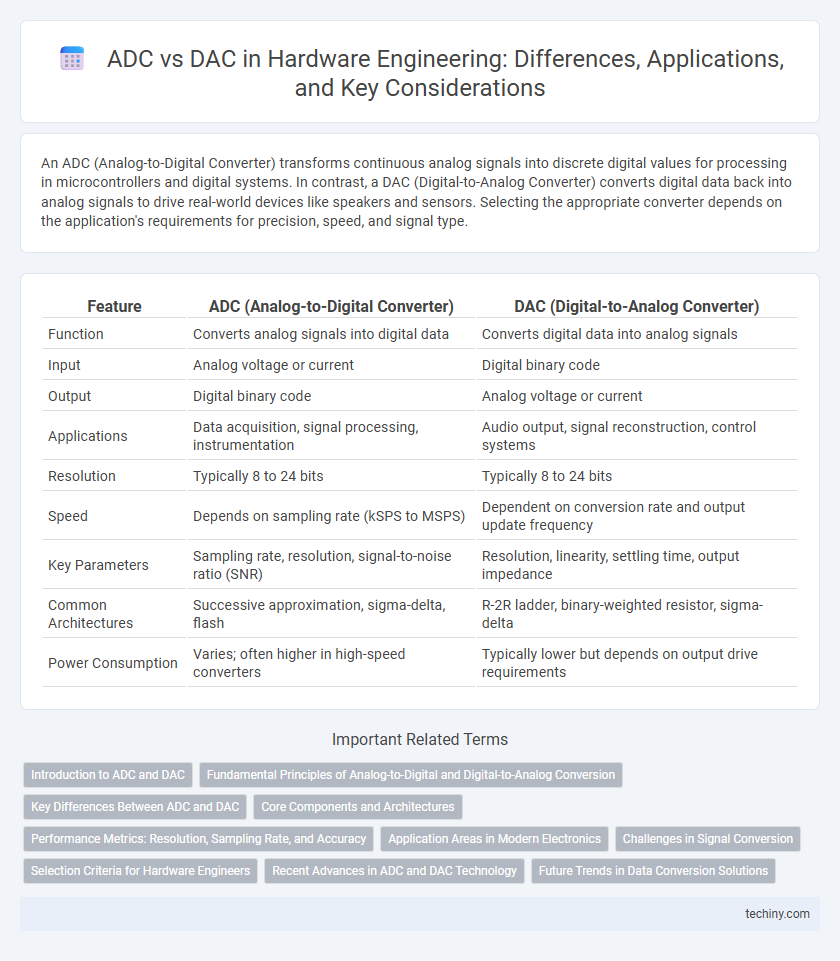An ADC (Analog-to-Digital Converter) transforms continuous analog signals into discrete digital values for processing in microcontrollers and digital systems. In contrast, a DAC (Digital-to-Analog Converter) converts digital data back into analog signals to drive real-world devices like speakers and sensors. Selecting the appropriate converter depends on the application's requirements for precision, speed, and signal type.
Table of Comparison
| Feature | ADC (Analog-to-Digital Converter) | DAC (Digital-to-Analog Converter) |
|---|---|---|
| Function | Converts analog signals into digital data | Converts digital data into analog signals |
| Input | Analog voltage or current | Digital binary code |
| Output | Digital binary code | Analog voltage or current |
| Applications | Data acquisition, signal processing, instrumentation | Audio output, signal reconstruction, control systems |
| Resolution | Typically 8 to 24 bits | Typically 8 to 24 bits |
| Speed | Depends on sampling rate (kSPS to MSPS) | Dependent on conversion rate and output update frequency |
| Key Parameters | Sampling rate, resolution, signal-to-noise ratio (SNR) | Resolution, linearity, settling time, output impedance |
| Common Architectures | Successive approximation, sigma-delta, flash | R-2R ladder, binary-weighted resistor, sigma-delta |
| Power Consumption | Varies; often higher in high-speed converters | Typically lower but depends on output drive requirements |
Introduction to ADC and DAC
Analog-to-Digital Converters (ADCs) transform continuous analog signals into discrete digital values, enabling microprocessors to interpret real-world data such as temperature, sound, or pressure. Digital-to-Analog Converters (DACs) perform the reverse function by converting digital signals back into analog form, essential for applications like audio playback and motor control. Both ADCs and DACs are critical components in hardware engineering for bridging the analog and digital domains in embedded systems.
Fundamental Principles of Analog-to-Digital and Digital-to-Analog Conversion
Analog-to-Digital Converters (ADCs) transform continuous analog signals into discrete digital values by sampling the signal at specific intervals and quantizing the amplitude into binary code. Digital-to-Analog Converters (DACs) perform the inverse operation, reconstructing continuous analog signals from digital binary codes through techniques such as zero-order hold or interpolation. Understanding the quantization noise, sampling rate, resolution, and linearity is crucial for designing effective ADCs and DACs in hardware engineering applications.
Key Differences Between ADC and DAC
ADC (Analog-to-Digital Converter) transforms continuous analog signals into discrete digital values, enabling microprocessors to process real-world inputs with precision. DAC (Digital-to-Analog Converter) performs the reverse operation, converting digital codes into continuous analog signals for output devices like speakers and monitors. The primary difference lies in their direction of conversion: ADC captures analog information into digital form, while DAC reconstructs analog signals from digital data.
Core Components and Architectures
ADC (Analog-to-Digital Converter) core components include a sample-and-hold circuit, quantizer, and encoder, designed to accurately convert continuous analog signals into discrete digital values. DAC (Digital-to-Analog Converter) architecture features key elements like a digital code register, decoder, and resistor or current ladder network, enabling precise reconstruction of analog signals from digital inputs. Both ADC and DAC architectures are optimized for speed, resolution, and linearity, using various topologies such as Sigma-Delta and Successive Approximation Register (SAR) to meet specific application requirements in hardware engineering.
Performance Metrics: Resolution, Sampling Rate, and Accuracy
ADC (Analog-to-Digital Converter) performance is primarily measured by resolution, sampling rate, and accuracy, where resolution defines the number of discrete levels for digital output, directly impacting signal detail representation. Sampling rate determines how frequently analog signals are converted per second, influencing bandwidth and signal reconstruction fidelity. DAC (Digital-to-Analog Converter) accuracy and resolution affect output signal precision, while its sampling rate governs the smoothness and frequency response of the analog signal derived from digital data.
Application Areas in Modern Electronics
Analog-to-Digital Converters (ADCs) are crucial in modern electronics for digitizing real-world signals in applications like sensor data acquisition, medical imaging, and communication systems. Digital-to-Analog Converters (DACs) find extensive use in audio playback devices, signal generation, and control systems where digital signals need conversion to analog form. Both ADCs and DACs enable seamless integration between analog environments and digital processing units, optimizing performance in embedded systems, instrumentation, and consumer electronics.
Challenges in Signal Conversion
ADC (Analog-to-Digital Converter) faces challenges such as quantization noise, limited resolution, and sampling rate restrictions, which can introduce distortion and reduce signal fidelity. DAC (Digital-to-Analog Converter) struggles with issues like output linearity errors, glitches, and settling time that impact the accuracy and stability of the reconstructed analog signal. Both ADC and DAC require precise clock synchronization and power management to minimize jitter and thermal noise, essential for high-performance signal conversion in hardware engineering.
Selection Criteria for Hardware Engineers
Hardware engineers select ADCs based on resolution, sampling rate, and input signal type to ensure accurate digital representation of analog signals. DAC selection prioritizes parameters like output linearity, settling time, and voltage range to achieve precise analog output from digital data. Both ADC and DAC choices depend heavily on system requirements such as power consumption, noise tolerance, and interface compatibility for optimal hardware performance.
Recent Advances in ADC and DAC Technology
Recent advances in ADC and DAC technology have significantly improved resolution, speed, and power efficiency, enabling more precise digital-to-analog and analog-to-digital conversions in complex hardware systems. Innovations such as delta-sigma modulation, time-interleaved architectures, and machine learning-assisted calibration contribute to enhanced signal integrity and reduced latency in high-frequency applications. These technological improvements support increasingly demanding uses in telecommunications, medical imaging, and autonomous systems where accurate signal processing is critical.
Future Trends in Data Conversion Solutions
Future trends in data conversion solutions emphasize the integration of high-speed, low-power ADCs and DACs to support next-generation communication systems and AI applications. Advances in semiconductor technology drive the development of mixed-signal integrated circuits featuring enhanced resolution and sampling rates, enabling precise and efficient signal processing. Emerging concepts like time-interleaved converters and machine learning-assisted calibration improve accuracy and reduce latency in real-time data conversion.
ADC vs DAC Infographic

 techiny.com
techiny.com